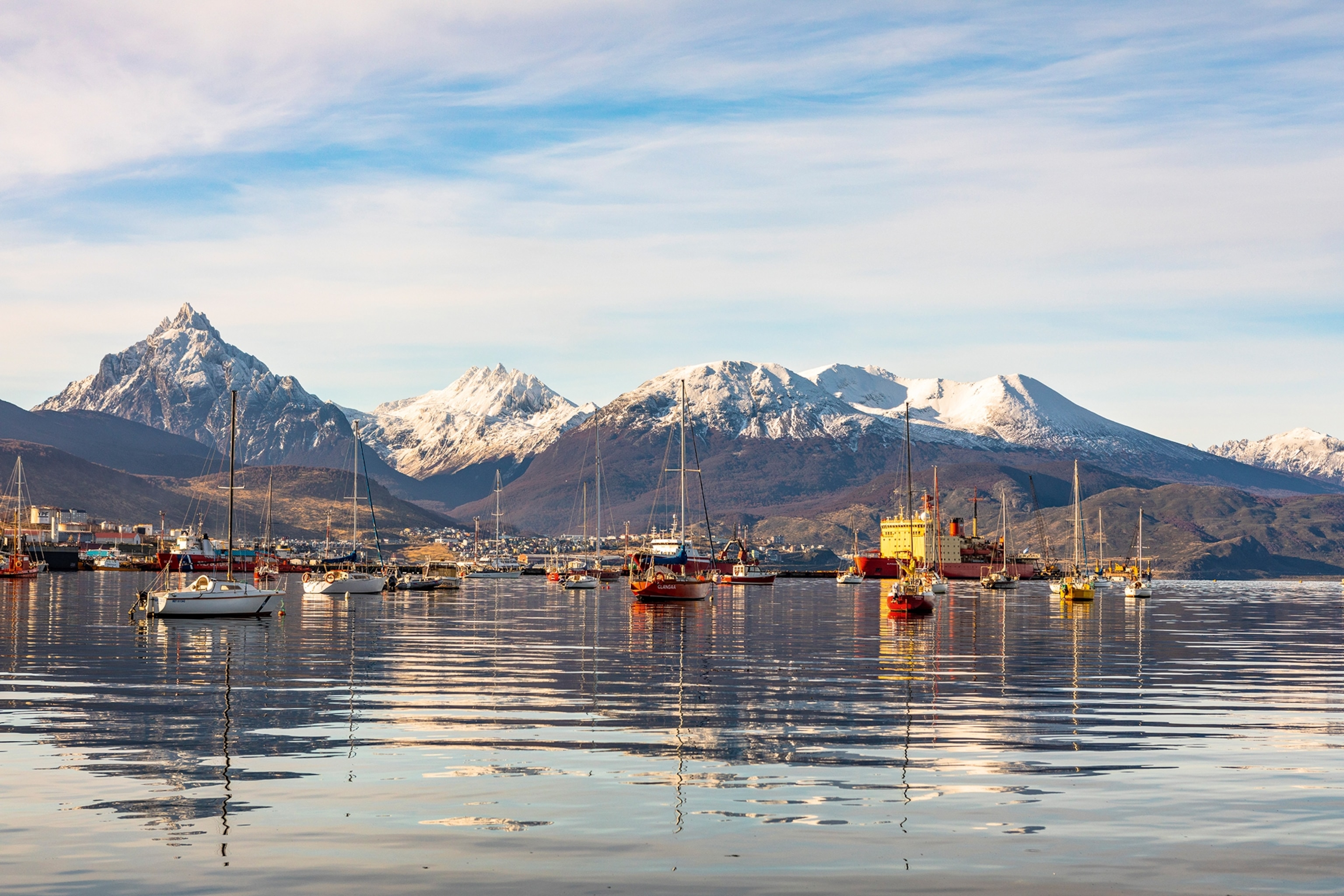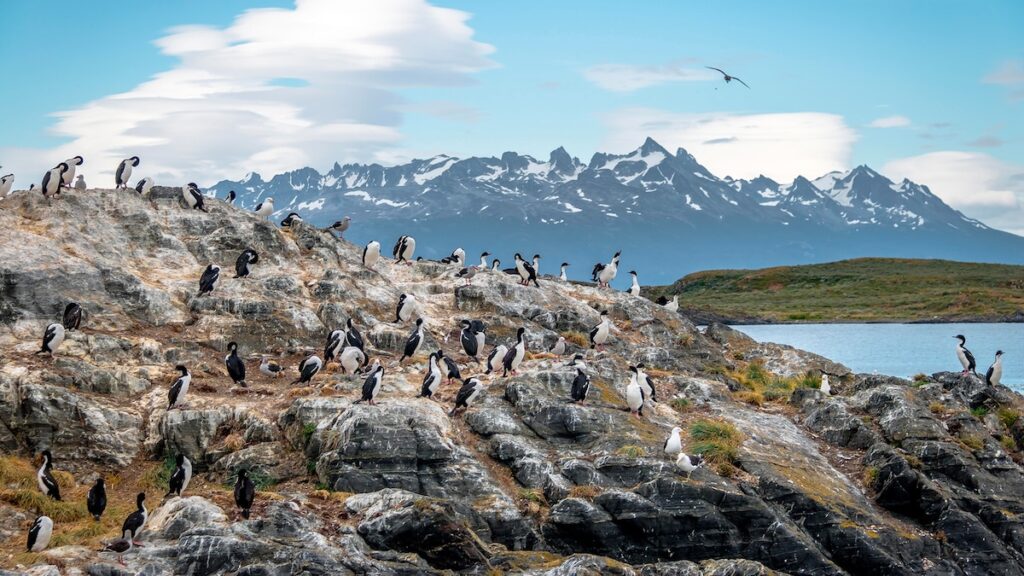This article was created by National Geographic Traveler (England).
Follow the icy banks of the Ukiga River and follow a path through a forest of southern beech evergreens dotted with clumps of orange mushrooms the shape and size of golf balls. The branches are miniature ecosystems, covered in tiny bryophytes (a group of plants that includes mosses, liverworts, hornworts, etc.) and tangled with irregular lichens known as old man's whiskers, which ripple as you walk by. Crooked roots and fallen trunks crisscross the path, and eerie creaking sounds echo as the canopy shakes in the fierce winds. No one else is around, but the air-beating sound of a Magellanic woodpecker periodically echoes over the noise, hiding its striking crimson head from view.
Eventually, I emerged from Huquica Municipal Park and watched the river cut across the stony coast, winding through Tierra del Fuego and emptying into the gunboat-gray Beagle Channel that connects the Atlantic and Pacific oceans. To my right is the hamlet of Vila Ukika, home to the small indigenous Yagan community. To my left is the outskirts of Puerto Williams, the southernmost city on Earth.
Below Patagonia, the tip of South America is torn apart by meandering waterways into an archipelago of islands, islets, capes, and peninsulas covered with bottle-green forests and glistening glaciers. This is Tierra del Fuego (“Land of Fire”). According to the oral tradition of the indigenous Selk'nam people, this formation was created by a young man named Tine who “grabbed stones and fashioned them with a catapult.”[shot] He threw them in all directions. In the place where the stone fell, a large crack appeared in the ground, which was filled with water. ”

Tierra del Fuego's poetic name was inspired by the Selk'nam bonfires. Photo by Christian Heeb, AWL Images
Tierra del Fuego's poetic name was inspired by the Selk'nam bonfire, discovered by Portuguese explorer Ferdinand Magellan in 1520 while attempting to become the first person to circumnavigate the world. Five thousand years later, this sparsely populated region straddling Argentina and Chile remains a wilderness. However, more and more tourists are heading to Antarctica, primarily through the Argentine port of Ushuaia, once a penal colony known as the “Siberia of the South” and now the largest city in Tierra del Fuego.
But some of these travelers sailed south through the Beagle Channel (named after the ship that took a young Charles Darwin on his momentous voyage around South America) to reach Puerto Williams' home base in Chile. Few people head to Navarino Island. The settlement of 2,800 people, whose status was upgraded from town to city by the Chilean government in 2019, is 1,500 miles from the capital, Santiago, but only 1,070 miles from Antarctica.
Puerto Williams is only accessible by plane or boat, and its isolated location is a big part of its appeal. For my first visit, pre-pandemic, I took the long route by taking a bus from the port of Punta Arenas in Chilean Patagonia, crossing the stormy Strait of Magellan by ferry, south to Isla Grande in Tierra del Fuego, and entering the Argentine section. I took it. We will drive through this region and end in Ushuaia after 12 hours. The next day, I crossed the Beagle Channel by boat, dodging noisy sea lion colonies across a series of rocky islets, and arrived at Puerto Navarino on the Chilean border, where I boarded a minibus and took one of the last stops along the coast. I aimed for the area. Puerto Williams.

The southern coast of the Beagle Channel with the Dientes de Navarino Mountains in the background. Photo by Kav Dadfar, AWL Images
This time, I chose the quickest option. A 30-minute flight from Punta Arenas offers stunning views of the snow-covered Alberto de Agostini National Park. This area captivated Darwin's imagination. Voyage of the Beagle About pods of spouting whales, stormy weather, and landscapes with “majestic glaciers”[ing] From the mountain side to the waterside. It is almost impossible to imagine anything more beautiful than the beryl blue of these glaciers.
Situated on the southern shores of the Beagle Channel, against the heavily forested slopes and snow-capped jagged peaks of the Dientes de Navarino Mountains, Puerto Williams is officially the capital of Chile's Antarctic Region. It retains the charm and atmosphere of a small town. Established as a naval base in the 1950s, it is in an area long inhabited by the Yagan community, with an area of clean whitewashed homes that is home to military personnel and their families (about half the population). Disproportionate private housing sprawls, complete with large satellite dishes, piles of firewood, and often shaggy dogs.
In the late afternoon sun, I wandered through the quiet, windswept streets, past a wooden church, a cluster of town halls, a small school, a few modest shops and restaurants (most of them closed), and a few others. I passed by that guest house. Cows and horses roam freely on the daisy-speckled lawns, and front doors are left unlocked, so crime is less likely in these areas. We stopped on a wooden boardwalk overlooking the Beagle Channel to watch petrels circle above a pair of fishing boats returning from catching extra-large king crabs.
After tasting delicious crustaceans for dinner in a restaurant decorated with marine trinkets, we chat with Anna Baldinger, who works at Hotel Fio Fio, our guesthouse. She originally moved to Puerto Williams from her native Austria to teach, but then she fell in love with both the local residents and Tierra del Fuego as a whole. “Puerto Williams is like living in a bubble. People think it's the village at the end of the world,” she explains.
The city may only be 70 years old, but the area has been home to a Yagan community for thousands of years, as evidenced by the ruins dotting the surrounding countryside. I'm here. Anthropologist Maurice Vandemele, owner of Hotel Fiofio, said Navarino has one of the world's highest archaeological densities, and there may be as many as 2,000 archaeological sites on the island. He said he was estimating. These include middens (prehistoric garbage dumps) and circular depressions that once housed ancient shelters, many of which I found on my drive from Puerto Navarino.
Maurice is the former director of the local museum, formerly known as the Martin Gushinde Museum of Anthropology. To recognize the region's long-neglected indigenous heritage, the Yaganúsi-Martín Gonzálezhe was renamed the Calderon Regional Museum. Located on the western edge of Puerto Williams, this eye-catching property features a giant sun-tanned whale skeleton on site. Inside, you'll gain fascinating insight into Yagan culture through items such as finely carved bone harpoons, exquisite jewelry, and finely crafted wooden canoes.
The museum also focuses on the devastation inflicted on indigenous people during the colonization of Tierra del Fuego in the late 19th and early 20th centuries. This era brought an influx of missionaries, gold miners, and sheep ranchers from Chile, Argentina, and other countries.
This area of Tierra del Fuego feels timeless, but change is coming. During my visit to Puerto Williams, I only saw about a dozen tourists, most of whom were there to hike, bird watch, fish for wild trout, or simply experience nature.the end of the world' ('The end of the world'). But more ships are on the way. Antarctic cruise ships now make more regular port calls and carry hundreds of passengers wearing matching jackets. Additionally, a state-of-the-art multi-purpose dock is being constructed that can service large ships. A new, larger hotel is also being built, and the small airport in Puerto Williams is being renovated, including plans for a new passenger terminal.
The latter is one of many infrastructure projects underway in Tierra del Fuego. The country's southernmost road, Y-905, ends near Villa Uquica, just east of Puerto Williams, and is replaced by a gravel road for the final 13 miles to Caleta Eugenia, a lonely ranch owned by the Chilean Navy. Masu. However, there is talk of extending the route to Puerto Toro, the world's southernmost permanently settled area, which is currently only reachable by boat. The Cape Horn Subantarctic Center, a cutting-edge scientific research hub, also recently opened in the city. Perched atop a hill east of the center, this glass and concrete structure houses its own wind turbine and vaguely resembles a spaceship.
But nagging concerns about overdevelopment quickly disappear as you walk west from Puerto Williams. At 2,000 feet above sea level, he has no one else on the path to the top of Bandera (“Flag Hill”). A steep switchback route through beech forest, it represents the first leg of the spectacular 33 meter Dientes de Navarino circuit. -Mile trekking. Gradually the trees thinned out, as if in homage, the trunks became more and more stunted, bowed their heads, and at the top they disappeared completely, replaced by a desolate subpolar tundra. .

Tierra del Fuego National Park is a hiker and birdwatcher's paradise. Photo by Maximilian Müller, Getty Images
Here I spotted a Chilean flag straining against a pole like a puppy on a leash. The stony terrain is dotted with green hammocks like slow-growing cushion plants and snooker tables, and streaked with snow. With the white-spotted Beagle Channel to the north and the Dientes de Navarino River cutting through the sky to the south, there are no other hikers in sight. It's a wonderfully remote place, characterized by near-constant winds and soaring temperatures.
Remembering that this is just a false summit, we slip into another base layer and follow the route along a series of cairns for another 40 minutes until we reach an exposed ridge with 360-degree views that somehow surpass the former. Admire glacial lakes surrounded by the crowns of snow-capped mountains. My hands are numb from the cold, and the sleet-like pimples are putting extra strain on my face, but I can't help but laugh as I recall the conversation I had with Anna the day before. “When you get to the top of Cerro Bandera, there’s no one in front of you,” she said. “And the rest of the world feels far away.”
Aerobias DAP operates flights between Punta Arenas and Puerto Williams, with flight times just over an hour.
Audrey Travel offers 16-day tours of Argentina and Chile via Ushuaia and Tierra del Fuego from £12,100 per person, including flights, in-destination transfers, accommodation, activities and excursions.
Click here to subscribe to National Geographic Traveler (UK) magazine. (Available in some countries only).


